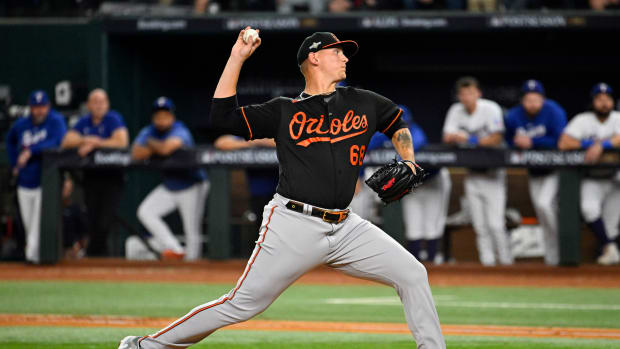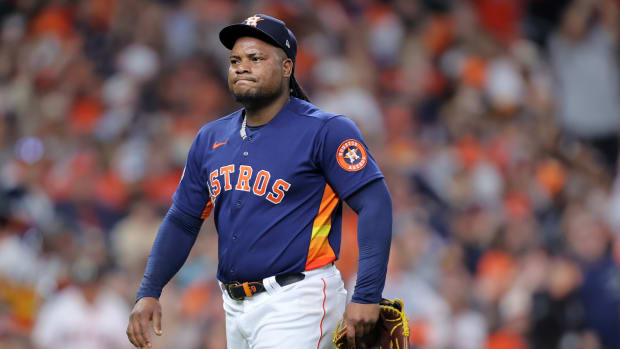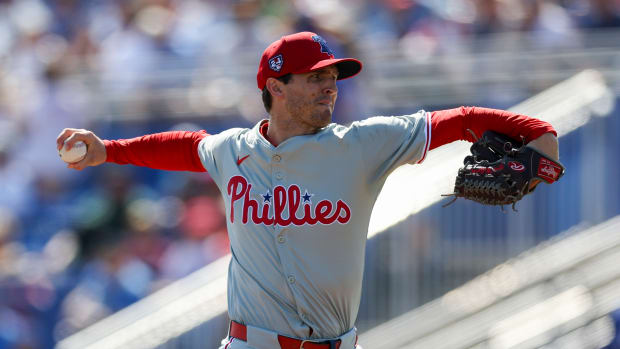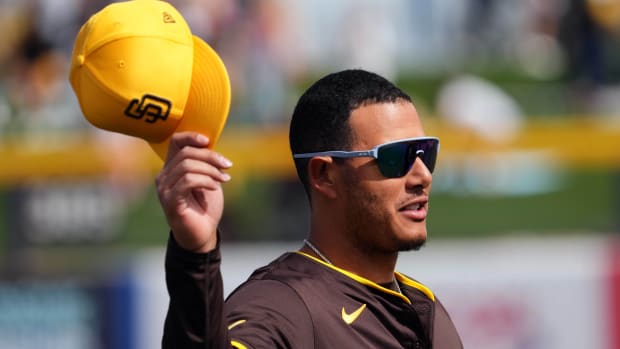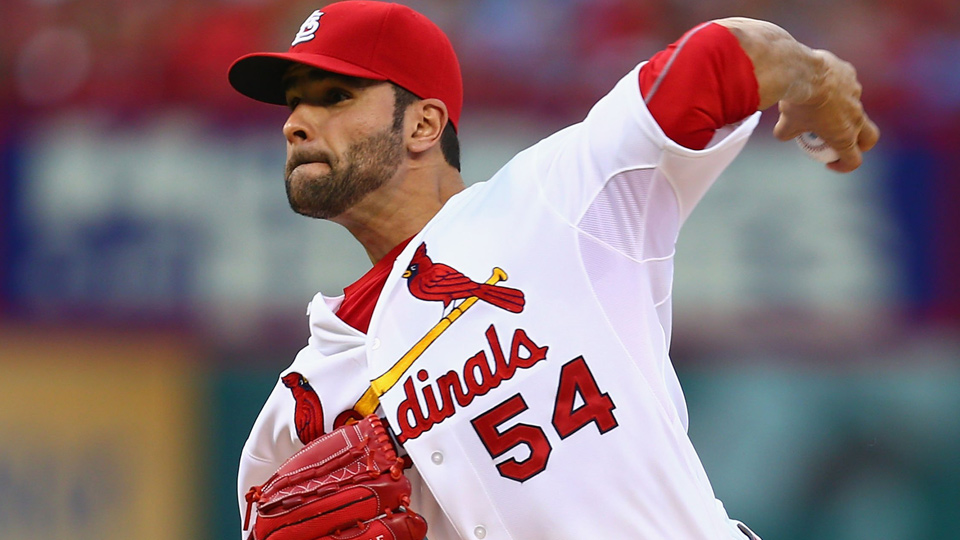
Cardinals' response to Jaime Garcia injury casts bad light on team
Already without Michael Wacha and Joe Kelly for extended periods of time, the Cardinals are now down another starting pitcher, as Jaime Garcia will undergo season-ending surgery to correct his thoracic outlet syndrome. As if that news weren't already bad enough, Cardinals general manager John Mozeliak publicly criticized the oft-injured lefty for the way he notified the team, exposing a layer of dysfunction in what's widely considered to be a model organization. So much for the Cardinal Way.
The 27-year-old Garcia was once a key member of the Cardinals' rotation. He put up a 3.17 ERA (120 ERA+) in 60 starts in 2010-2011, placing third in the NL Rookie of the Year voting in the former year and helping the team win a World Series in the latter, but since then, he's battled a variety of shoulder problems. Partial labrum and rotator cuff tears limited Garcia to 20 starts in 2012 and nine in 2013 before he underwent surgery last May 24. He began this year on the disabled list, battling shoulder inflammation before making his season debut on May 18, six days shy of a year since his surgery. Garcia ended up making just seven starts, pitching to a 4.12 ERA with a 39/7 strikeout-to-walk ratio, before going on the disabled list on June 20 with what was described at the time as discomfort that had surfaced over his previous couple of starts.
With the team's blessing, Garcia consulted with multiple specialists regarding his shoulder, including Dr. George Paletta, the former team physician who performed his shoulder surgery, and Dr. Greg Pearl, the Dallas physician who performed Chris Carpenter's 2012 thoracic outlet syndrome surgery. He also spoke to Carpenter and "six or seven" other pitchers who have suffered from the same symptoms — numbness in his throwing hand, tingling in his neck, shooting pain down his arm after every pitch.
Thoracic outlet syndrome, which is caused by a compression of the nerves and/or blood vessels somewhere between the neck and the armpit and is generally remedied by the removal of a cervical rib, is not a career-ending injury by any means. Pitchers such as Kenny Rogers, Matt Harrison and Josh Beckett have recovered from the surgery to fare well at the major league level. But others, such as Carpenter and Jeremy Bonderman, were never the same after the procedure. Carpenter made six starts in the majors in late 2012 after undergoing the surgery, but his symptoms recurred last spring, and he made just two starts in the minors (none in the majors) before retiring last November.
The disconnect between Garcia and the team's front office stemmed from the pitcher deciding to undergo the surgery so soon instead of attempting to rehab, and of sharing that information with the media before he did so with the team. From the St. Louis Post-Dispatch's Derrick Goold and Joe Trezza:
Although he was offered a menu of rehab options before having surgery, Cardinals starter Jaime Garcia alerted the Cardinals this morning that he intends to have a procedure this coming week that will end his season.
..."He's been a hard guy to count on," Mozeliak said of the oft-injured lefty. "He's been a hard guy to keep on the field."
...The club was irritated by how Garcia notified them.
"It could have been handled a little different," Mozeliak said. "This (injury) appears to have generated itself in the last couple weeks."
Ouch. While Mozeliak's disappointment at Garcia not following protocol with regards to informing the team of his decision first is understandable, the player has the right to choose which course of treatment he takes. As with the recent wave of Tommy John surgeries, it's understandable that one experiencing TOS symptoms might decide to cut to the chase given the rarity of successful rehab without surgery.
Beyond that, hearing a respected executive publicly trash an injured player at a career crossroads is cringeworthy enough even before considering that Garcia had gutted his way through pitching through those partial tears in his shoulder; he was diagnosed in June 2012 and missed two and a half months but returned to make nine starts in August and September, pitching better after his absence (3.25 ERA) than before (4.48 ERA). Such a tack taken by an executive recalls the early 2010 battle between the Omar Minaya-eraMets — a team drowning in dysfunction, particularly with regards to their handling of injuries — and Carlos Beltran over his osteoarthritic right knee; the team claimed that Beltran underwent the surgery without their consent, a stance that Beltran's agent, Scott Boras, refuted.
According to the Post-Dispatch's Joe Strauss, the team's handling of Garcia's 2012 injury underlies the gap between the two sides:
The latest shutdown occurred 13 months after Garcia required surgery to address labrum and rotator cuff issues. The decision to pursue another, less certain procedure comes two years after a fissure developed between the team’s medical and training staffs about the proper strength program for Garcia’s shoulder.
… Garcia’s situation was one of several that became a tug-of-war between longtime Cardinals medical supervisor Dr. George Paletta, the Cardinals' training staff and team Injury & Performance Specialist Dr. Clayton Skaggs, a chiropracter who heads a Kirkwood institute that counts numerous former and current Cardinals players as clients. Paletta and Skaggs clashed in 2012 over the proper strengthening program for the lefthanded starter. At one point Garcia sought what became a contentious meeting to challenge Skaggs’ program.
The roiling medical rift appeared to resolve itself when the Cardinals announced this spring they were turning over all player care to Mercy Hospital, their official medical provider. A lengthy March news release confirmed the club was cutting ties to Paletta and fellow orthopedic surgeon Dr. Lyndon Gross.
Beyond the dysfunction, Garcia's loss hits the Cardinals at a time when the team (47-42) has slipped from second place to third in the NL Central, five games behind the division-leading Brewers and half a game behind the resurgent Pirates. Driven by a league-low 0.6 homers allowed per nine, St. Louis’ rotation as a whole ranks third in the league with a 3.22 ERA, but beyond ace Adam Wainwright (1.89 ERA), Lance Lynn (3.17 ERA) and the injured Wacha (3.02 ERA) — all of whom have pitched about as well as their peripherals suggest — the remaining starters have put up a 4.18 ERA with just a 31 percent quality start rate.
Shelby Miller (4.15 ERA, 87 ERA+) has been unable to match his stellar rookie season; he's walking 4.3 per nine while striking out just 6.2. Rookie Marco Gonzales, who joined the rotation when Garcia hit the DL last month, has been tagged for a 7.07 ERA in three starts. Carlos Martinez has pitched to a 2.65 ERA in four starts, but he's averaged just 4.58 innings per turn, and his move to the rotation has cost the team its top setup man in front of closer Trevor Rosenthal, who has been shaky (3.76 ERA, 5.3 BB/9) thus far.
Help is on the way in the form of Kelly, who made just three starts before suffering a hamstring strain. He's made two rehab starts, most recently throwing four scoreless innings and 49 pitches for the team's Triple-A Memphis affiliate on July 3. He'll likely make two more starts — taking him through the All-Star break — before returning to the big club. Wacha (2.79 ERA) was on his way to a strong follow-up of his abbreviated rookie season but has been out since June 18 due to a stress reaction in his shoulder, a precursor of the type of scapular fracture that has dogged Brandon McCarthy in recent years. The timetable for his return is unknown, but it almost certainly won't happen before August, as he will likely have to build up arm strength on a spring training-type program.
All of that may push the Cardinals to trade for a starter as the July 31 deadline approaches. They certainly have the prospects to go big-game hunting for David Price, but they may view his cost as prohibitively high, particularly in the wake of the Jeff Samardzija deal. Infield help is also a priority given the team's lagging offense, which is 14th in the league in scoring at 3.69 runs per game after cranking out an NL-high 4.83 per game last year.
As for Garcia, realistically, he may not have been able to provide more than a handful of starts had he opted for a more conservative approach to treatment. What remains to be seen is how the team handles this rift going forward given that Garcia is signed through 2015 as part of a four-year, $27 million deal; he'll make $9.25 million next year, and the team has options for 2016 ($11.5 million) and 2017 ($12 million) with $500,000 buyouts on each. Given his current condition, he’ll be difficult to trade before next spring, but it’s going to take a whole lot of air-clearing before the team counts on him again.
The Cardinals would do well to keep that conversation under wraps, because their public criticism not only undercuts Garcia’s value but also tarnishes the reputation of an executive and a team that are held in high esteem. Whatever the nebulous definition of the Cardinal Way may be, kicking an injured and vulnerable player when he’s down is the antithesis of a well-run organization.































